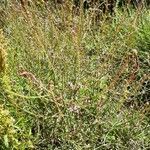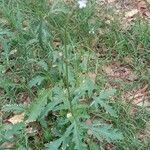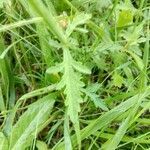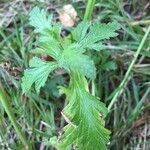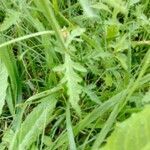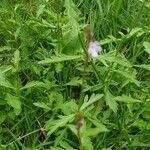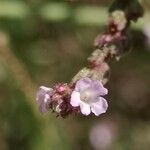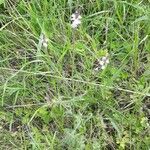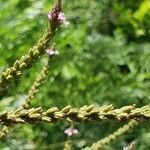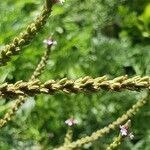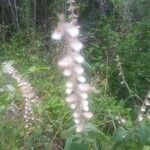Annual or short-lived perennial; stems to 80 cm tall, square, often scabrid on angles. Most lvs variously pinnatifid or pinnatisect (basal ones often deeply toothed), mostly petiolate (uppermost often sessile), sometimes scabrid, with hairs little swollen at base; lamina 3-6 × 1-4 cm, ± rhombic or oblanceolate; lobes oblong or ovate; veins not impressed above; base ± attenuate; apex obtuse to acute. Infl. very loosely paniculate; spikes to c. 15 cm long at maximum flowering, elongating to 25 cm at fruiting, slender, puberulent; fls soon becoming distant. Bracts 1/2-⅔ length of calyx, lanceolate to ovate, somewhat keeled, acuminate, hairy. Calyx 2-3 mm long, hairy; teeth acute, green or mauvish. Corolla tube > calyx, somewhat hairy outside; limb 4-5 mm diam., mauve or lavender, drying a similar colour. Nutlets c. 2 mm long, oblong, reddish brown, strongly ribbed dorsally, finely white-papillate and flattened ventrally.
Annual herb, up to 1.6 m high; stem woody and unbranched below, with a few long inflorescence branches above, leafy. Leaves ovate in outline, 20-70 x 8-85 mm, 3-partite to pinnatifid; lobes with apex acute or obtuse, base narrowly cuneate, semi-amplexicaul; bluntly serrate; leaves of upper branches lanceolate or oblanceolate to linear. Inflorescences of many, elongate, terminal and axillary, slender spikes; bracts ovate-lanceolate, attenuate-acuminate. Flowers lilac or mauve to magenta, purple, violet or blue, glabrous. Calyx subcylindric, glandular-pubescent outside. Corolla; tube narrowly cylindric; limb subequally 5-lobed. Fruit of 4, dry, brown, oblong nutlets. Flowering time Dec.-Apr.?.
Perennial herb 0.3–1 m high; branches erect, quadrangular, smooth or ridges finely scabrous. Leaves shortly petiolate or sessile, strigose; lower leaves coarsely toothed to pinnatifid or 1–2-pinnatisect, 2–7 cm long, 0.5–3 cm wide; upper leaves incised to subentire, smaller than lower leaves, ovate-cuneate, oblong or narrowly ovate; base ±acute; apex acute (upper leaves) or obtuse (lower leaves). Inflorescence a lax terminal panicle with long branches ending in a spike; bracts shorter than calyx, with peduncle, bracts and calyx strongly glandular. Calyx 5-toothed, 2.5–3 mm long. Corolla pale pink or lilac, twice as long as calyx; tube 3–3.5 mm long. Mericarps length 1.5–2 mm long.
Slender annual 2–6 dm, ascending or erect, the stem glabrous or nearly so; lvs 2–7 cm, strigillose, the lower ones ± ovate, narrowed to a petiole, 1–2-pinnatifid or 3–5-cleft with the parts again incised, the upper ones smaller and less dissected; spikes elongate, very slender, paniculately disposed or in 3’s or even solitary; bracts usually half as long as the cal; cal 2–2.5 mm, glandular-hairy, subtruncate, its teeth minute; cor blue, purple, or lilac, the tube to 3 mm, the limb 4 mm wide, with ± rounded lobes; nutlets 2 mm; 2n=14, 28. Native of Europe, naturalized along roadsides and in fields and waste places in se. U.S., n. to Mass. and possibly Me. June–Sept.
Herbs, annual or weakly perennial, erect, 30-140 cm tall, pubescent to subglabrous. Leaves narrowed into a petiole 0.3-4 cm; leaf blade ovate, obovate, or oblong, 2-8 X 1-5 cm, papery, hirsute especially on abaxial veins, margin coarsely dentate or cut to sometimes deeply pinnatifid or lobed. Spikes long, slender; bracts as long as calyx. Calyx 1-4 mm, pubescent, glandular. Corolla blue to pink, (2-)4-8 mm, pubescent. Ovary glabrous. Nutlets oblong, ca. 2 mm. Fl. and fr. Jul-Oct. 2n = 14.
An evergreen shrub. It grows 30 cm to 1 m high. The roots are branched and are white or yellow. The stem has hairs. The leaves are about 2.5-8 cm long and 1-1.5 cm wide. The flowers are small and blue. The fruit are divided into 4 segments. It is bitter with a sweet smell.
Perennial herb, 0.3-0.6(-1,0) m high. Stem scabrid on angles, usually erect. At least lower leaves deeply incised to 1-or 2-pinnatisect, petiolate. Spikes slender, fruiting spikes 100-250 mm. Flowers pale pink, purple or blue.
